Tuesday 10 June 1941
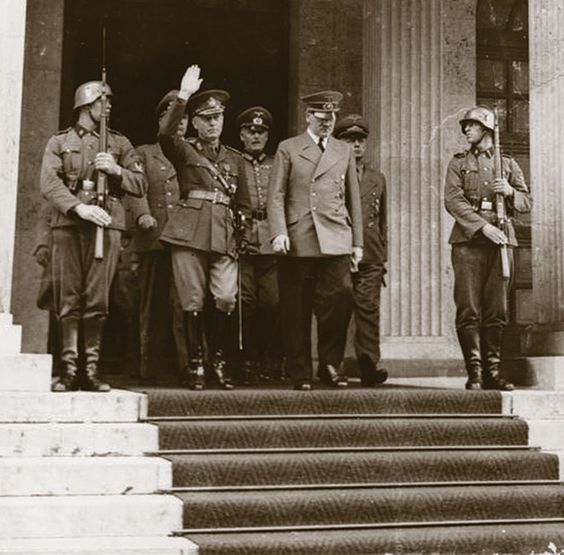 |
| Adolf Hitler and Romanian General Ion Antonescu at the Führerbau in München, 10 June 1941. Also visible are German Foreign Minister Joachim Ribbentrop and Field Marshal Keitel (Federal Archive Bild 183-B03212) |
Syrian/Lebanon Campaign: Operation Exporter, the British Commonwealth invasion of Syria and Lebanon, continues. Progress slows today,
10 June 1941.
Following its contested crossing of the Litani River, the Australian 21st Brigade advanced north past Tyre toward Sidon. However, the French stop it during the afternoon. In the center of the front, the 25th Brigade advances toward Merdjayoun. The Vichy French, though, are readying powerful forces to defend Merdjayoun and gathering forces at other points along the front as well.
Free French 1st Infantry Brigade and 2nd Infantry Brigade attack Kissoue south of Damascus. They capture several villages.
The French military orders the French 7 Squadron, 1st Fighter Group to "drive off small units of the British Navy." The Royal Navy effectively has been parking offshore and aiding the advance onshore. The fighters fail in this task because they quickly find out that the entire British 15th Cruiser Squadron is in action and fighters have no chance of making a dent in this force. The French 6 Squadron, 3rd Fighter Group (Capitaine Jacobi) is shot down by British anti-aircraft guns.
The RAF, for its part, forms No. 127 Squadron at Habbaniya, Iraq. It begins operations with four Hawker Hurricanes and four Gloster Gladiators.
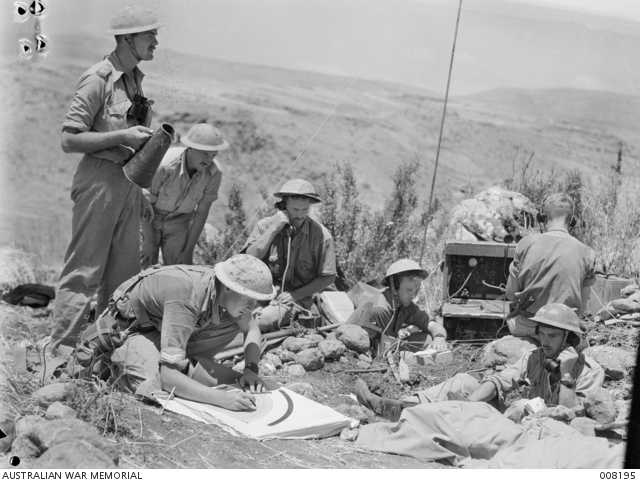 |
| "NEAR KHIAM, SYRIA. THE COMMAND POST OF "D" TROOP OF THE 12TH BATTERY OF THE 2/6TH FIELD REGIMENT DURING ACTION AGAINST THE FRENCH IN THE MERDJAYOUN SECTOR. NOTE THE PLOTTING BOARD IN USE, THE MEGAPHONE GIVING ORDERS TO THE GUNS AND THE RADIO AND FIELD PHONES FOR RECEIVING FIRE DIRECTIONS." 10 June 1941 (Australian War Memorial 008195). |
European Air Operations: The Luftwaffe bombs Pembroke with 35 bombers during the night.
During the day, RAF Fighter Command sends Rhubarb missions over Belgium. After dark, RAF Bomber Command attacks Brest with 104 bombers. Their goal is to sink cruisers Prinz Eugen, Scharnhorst, and Gneisenau, but no hits are made.
East African Campaign: Operation Chronometer begins. British troops of the 3rd battalion of 15th Punjab Regiment based in Aden land at Assab, the last Italian port on the Red Sea. They are carried there by a transport escorted by light cruiser HMS Dido (which bombards the port from 05:05-05:12), armed boarding vessel Chakdina, and Indian sloops Clive and Indus. The troops land at 05:19 and achieve complete surprise. They capture five batteries of coastal guns manned by the Italian Navy. The port is captured by 06:00, with 547 Italians and 35 Germans going into captivity.
The capture of Assab is of huge importance because it enables the US Government to retract the designation of the Red Sea as a combat zone. Thus, once Assab is captured, US freighters no longer will have to unload their cargoes for transfer to British ships at Cape Town, but instead can sail uninterrupted up to Suez. This provides a huge efficiency advantage.
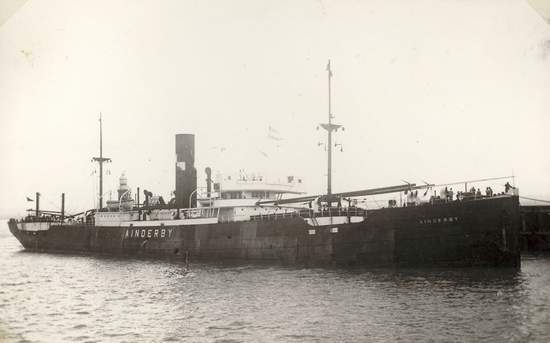 |
| The Ainderby, sunk on 10 June 1941 by U-552. |
Battle of the Atlantic: U-204 (Kptlt. Walter Kell), serving with Wolfpack West east of Newfoundland on its first patrol out of Kiel, torpedoes and sinks 7886-ton Belgian freighter Mercier. There are 7 deaths.
U-108 (Kptlt. Klaus Scholtz), also serving with Wolfpack West on its third patrol out of Lorient, completes a day-long pursuit when it finally torpedoes and sinks 1992-ton Norwegian freighter Christian Krohg. Everyone on board perishes.
U-552 (Oblt. Erich Topp), on its third patrol out of St. Nazaire and operating off the northwest coast of Ireland, torpedoes and sinks 4860-ton British freighter Ainderby. There are 12 deaths.
The Luftwaffe bombs and damages 5404-ton British freighter Clearpool near Scarborough. There are two deaths. The Clearpool makes it to Tees and thence proceeds to Hartlepool for repairs.
British 1444-ton freighter Royal Scot, part of Convoy FN-477, hits a mine and sinks near 62 Buoy in the Humber River entrance. There are three deaths.
Royal Navy patrol sloop HMS Pintail hits a mine and sinks off the Humber while escorting Convoy FN-477. There are 52 deaths, including master Lt. J.L.E. McClintock, and 22 survivors.
Minelayers HMS Agamemnon and Menestheus lay minefield SN-64 in the Faroes North Rona sector.
Convoy OB-333 departs from Liverpool, Convoy HX 132 departs from Halifax, Convoy SC-34 departs from Sidney CB bound for the Clyde, Convoy AP-41 (VK-12) departs from Wellington escorted by HMAS Australia.
 |
| Royal Navy patrol vessel HMS Pintail, based in Harwich. The Pintail is near 62-Buoy about 30 miles off the Humber when a ship it is escorting, the Royal Scot, hits an acoustic mine. The Pintail goes to the scene but also triggers an acoustic mine. The Pintail blows up and sinks within seconds. |
Battle of the Mediterranean: The encircled Tobruk garrison is beset with artillery fire and air raids. There are several casualties. One of the main difficulties for the Australian defenders, though, is flies - there are hordes of them in the cookhouse. Many of the Luftwaffe bombs turn out to be duds, so there are many unexploded bombs scattered about the port. Discipline is lagging in certain quarters due to the extended encirclement, with men falling asleep while on guard duty and the like. The siege of Tobruk is a war of nerves along with one laced with bullets and bombs.
Royal Navy submarine HMS Torbay, operating in the Dardanelles, makes two unsuccessful attacks on ships due to defective torpedoes. The third attack is the charm, as it torpedoes and sinks 3319-ton Italian freighter Giuseppina Ghirardi about 15 miles from Cape Helles.
The Luftwaffe bombs and damages 7241-ton British freighter Durenda near Port Said. The Durenda makes it to Port Said for temporary repairs, and thence to Bombay for permanent repairs.
An Axis convoy of six vessels departs from Naples bound for Tobruk.
POWs: Lord Simon meets with prisoner Rudolf Hess for over two hours. Hess urges the British to seek peace with Germany.
 |
| "Looking from the top of the hangar of HMS SUFFOLK toward the arctic ice fields." June 1941. © IWM (A 4193). |
US/Bolivian Relations: Rejecting a Japanese offer, Bolivia agrees to sell its tungsten to the USA for the next three years. Tungsten is important in machine tools and anti-tank shells. Axis war production is short of tungsten carbide throughout the war, Germany's main source in China ended in July 1937 when the Japanese invaded. All of this relates to an important but little-remembered war over economic resources during World War II.
US/Portuguese Relations: The US State Department reassures Portugal that it has no designs on its islands in the Atlantic.
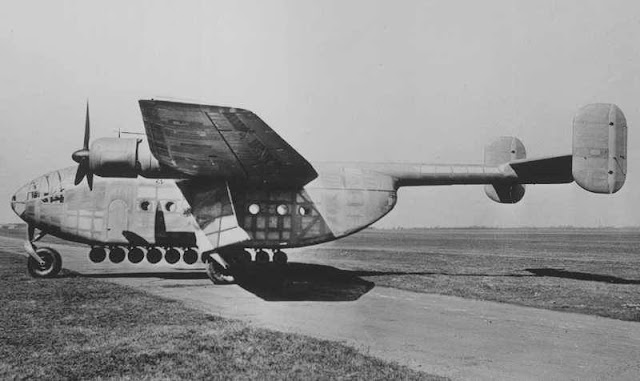 |
| The Arado Ar 232 Tausendfüßler (German: "Millipede"). Its first flight is in June 1941. The AR-232 was intended as a replacement for the Junkers Ju 52, but, though development continued throughout the war, only about 20 were built. |
US/Italian Relations: Benito Mussolini makes a speech to the Grand Council of Fascism on the first anniversary of the entry of Italy into the war. He states that, while the United States has entered a de facto state of war with Germany and Italy, "America's attitude does not bother us excessively... American intervention would merely lengthen the war and would not save England."
German/Romanian Relations: Continuing his round of diplomatic audiences in preparation for Operation Barbarossa, Adolf Hitler hosts Romanian strongman General Ion Antonescu at the Fuhrer's Building in Munich. Also attending are Foreign Minister Joachim Ribbentrop and Field Marshal Wilhelm Keitel. They have a reception afterward. Hitler spends several hours talking with Antonescu - and Hitler indeed usually does all the talking at such meetings - and it is likely that he briefs Antonescu on preparations for Operation Barbarossa.
Japanese/Russian Relations: Japanese and Soviet negotiators, concluding secret talks taking place in China, reach an agreement on Manchurian/Russian border delineation. Japanese diplomats at Hsinking, Manchukuo also send reports to Tokyo and the embassy in Moscow concerning 27 Soviet armored trains carrying 800 trucks they notice en route between Chita and Manchuli. The Japanese interpret this as possible warlike intentions by the Soviets.
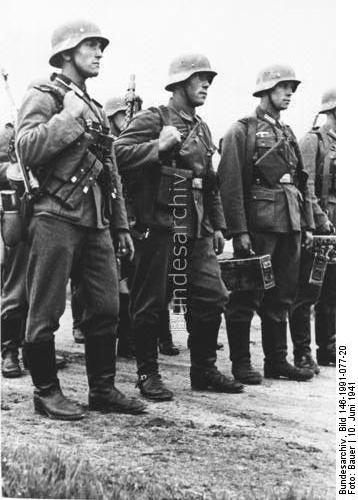 |
| German troops preparing for Operation Barbarossa. The original caption: "The equipment has gotten better. The group before the departure. The men know each other, are attuned to each other, the best possible fighting power can be brought out." 10 June 1941 (Farmer/Bauer, Federal Archive, Bild 146-1991-077-20). |
Finnish Military: The Finnish military begins mobilizing for Operation Barbarossa. This will be known in Finland as the "Continuation War." As the Finns do not know about Operation Barbarossa, at least officially, the military call-up is for "maneuvers." The troops are ordered to deploy according to wartime plans even though there is no war - yet.
US Military: The US Army Air Corps forms the 3d Photographic Reconnaissance Squadron.
William "Wild Bill" Donovan, a Roosevelt crony, submits a proposal for a new intelligence agency based on his contacts with British Intelligence (MI6) during his recent trip to Europe. The United States at this time has no formal spy agency, and Donovan proposes one. This will lead to his being appointed Coordinator of Information on 11 July. This results eventually in the Office of Strategic Services (OSS), which becomes the Central Intelligence Agency (CIA).
 |
| Lisbon, 10 June 1941. A group of Jewish refugees waits in line to board a ship to the United States. Photo: United States Holocaust Memorial Museum. |
British Government: Prime Minister Winston Churchill appears before the House of Commons to defend the government's handling of the failed defense of Crete. He has testy exchanges with former Secretary of State for War Leslie Hore-Belisha, a frequent adversary, who notes correctly that, "For the first time in history an island has been captured by an airborne attack." Churchill lamely claims that the German capture of Crete was a good learning experience and diverts the focus to British triumphs instead:
I have not heard that Herr Hitler had to attend the Reichstag and say why he sent the Bismarck on her disastrous cruise. I have not heard that Signor Mussolini has made a statement about losing the greater part of his African Empire.
Comparing himself to Hitler and Mussolini is a remarkable moment for Churchill, who does not see anything wrong with that - and something that a minority of Great Britain's people would see as entirely appropriate for very unflattering reasons. Churchill expresses irritation that the House is interfering with his conduct of the war, suggesting that the government - meaning him - should decide when the House debates war issues. There is little question that this is a low point of the war for Churchill.
French Homefront: Vichy Vice-Premier Admiral François Darlan makes a radio broadcast to the French nation. he warns that some are "trying to darken the nation's understanding." By this, he means both Free French General Charles de Gaulle and "Communist propaganda," which have:
the same goal - to create disorder in the country, to increase the misery of the population, to prevent the rebirth of the nation ... Frenchmen, beware and help the government in its heavy, very heavy task. This task of the government is triple: to ameliorate the French people's situation, to prepare for peace in that measure a conquered nation can, and to prepare France's future in a new Europe.
The occupation authorities expel more foreign diplomats from occupied Paris.
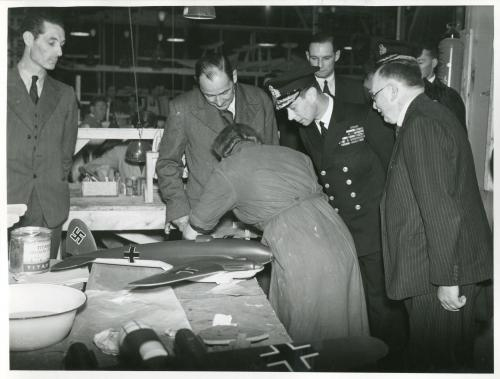 |
| King George VI at Merton, 10 June 1941 With Walter Lines, His Majesty is observing munitions made by toy manufacturer Lines Bros. (V&A Museum of Childhood). |
|
British Homefront: King George VI visits the Lines Bros. Ltd. factory at Merton, South London. He inspects the munitions production being undertaken by the Lines Bros, which is a toy manufacturer.
American Homefront: New York Yankee Joe DiMaggio gets a close call from the official scorer which extends his hitting streak to 25 games. In the seventh inning, he hits a sharp liner directly at Chicago White Sox' third baseman, Dario Lodigiani. Lodigiani is "handcuffed" by the sharply hit ball and cannot make a play. This call could go either way, but the scorer marks it down as a hit. Since the game is played in Chicago's Comiskey Park, it definitely is not an instance of "homefield scoring" in favor of Dimaggio.
Future History: Mickey Jones is born in Houston, Texas. He becomes a drummer for musical acts including Trini Lopez, Kenny Rogers, Johnny Rivers, and The First Edition. He also acts in films such as "Sling Blade" and "Tin Cup." Micky Jones passes away on 7 February 2018.
Jürgen Prochnow is born in Berlin, Germany. He becomes an international film star in films such as "Air Force One" (1997) and "Beverly Hills Cop II" (1987). Prochnow is born one day after the final success of U-46, which is the U-boat after which the one in "Das Boot" (1981) - his most famous film - is modeled. Prochnow continues to act as of this writing, splitting his time between English-language and German productions. Prochnow receives US citizenship in 2003.
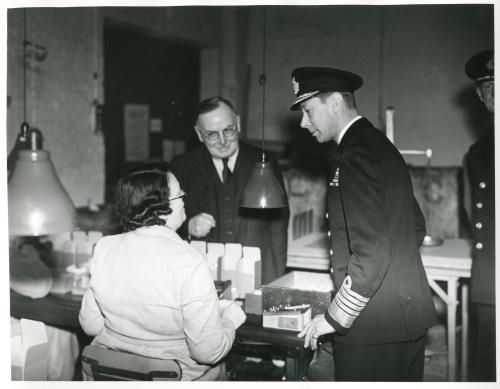 |
| King George VI at Merton, 10 June 1941 With Walter Lines, His Majesty is observing munitions made by toy manufacturer Lines Bros. (V&A Museum of Childhood). |
June 1941 June 1, 1941: Farhud PogromJune 2, 1941: Massacres on CreteJune 3, 1941: Kandanos MassacreJune 4, 1941: Kaiser Wilhelm Passes AwayJune 5, 1941: Death in ChungkingJune 6, 1941: Hitler's Commissar OrderJune 7, 1941: Commandos Strike at PessacJune 8, 1941: British Invade Syria and LebanonJune 9, 1941: Litani River BattleJune 10, 1941: British Take AssabJune 11, 1941: Hitler Thinking Beyond RussiaJune 12, 1941: St. James AgreementJune 13, 1941: Lützow DamagedJune 14, 1941: Latvian June DeportationsJune 15, 1941: Operation BattleaxeJune 16, 1941: The Old LionJune 17, 1941: British Spanked in North AfricaJune 18, 1941: Turkey Turns Its BackJune 19, 1941: Cheerios IntroducedJune 20, 1941: Birth of US Army Air ForceJune 21, 1941: Damascus FallsJune 22, 1941: Germany Invades RussiaJune 23, 1941: A Soviet KV Tank Causes HavocJune 24, 1941: Kaunas and Vilnius FallJune 25, 1941: Finland Declares WarJune 26, 1941: Bombing of KassaJune 27, 1941: Encirclement At MinskJune 28, 1941: Minsk FallsJune 29, 1941: Brest Fortress FallsJune 30, 1941: Mölders Becomes Top Ace2020





















